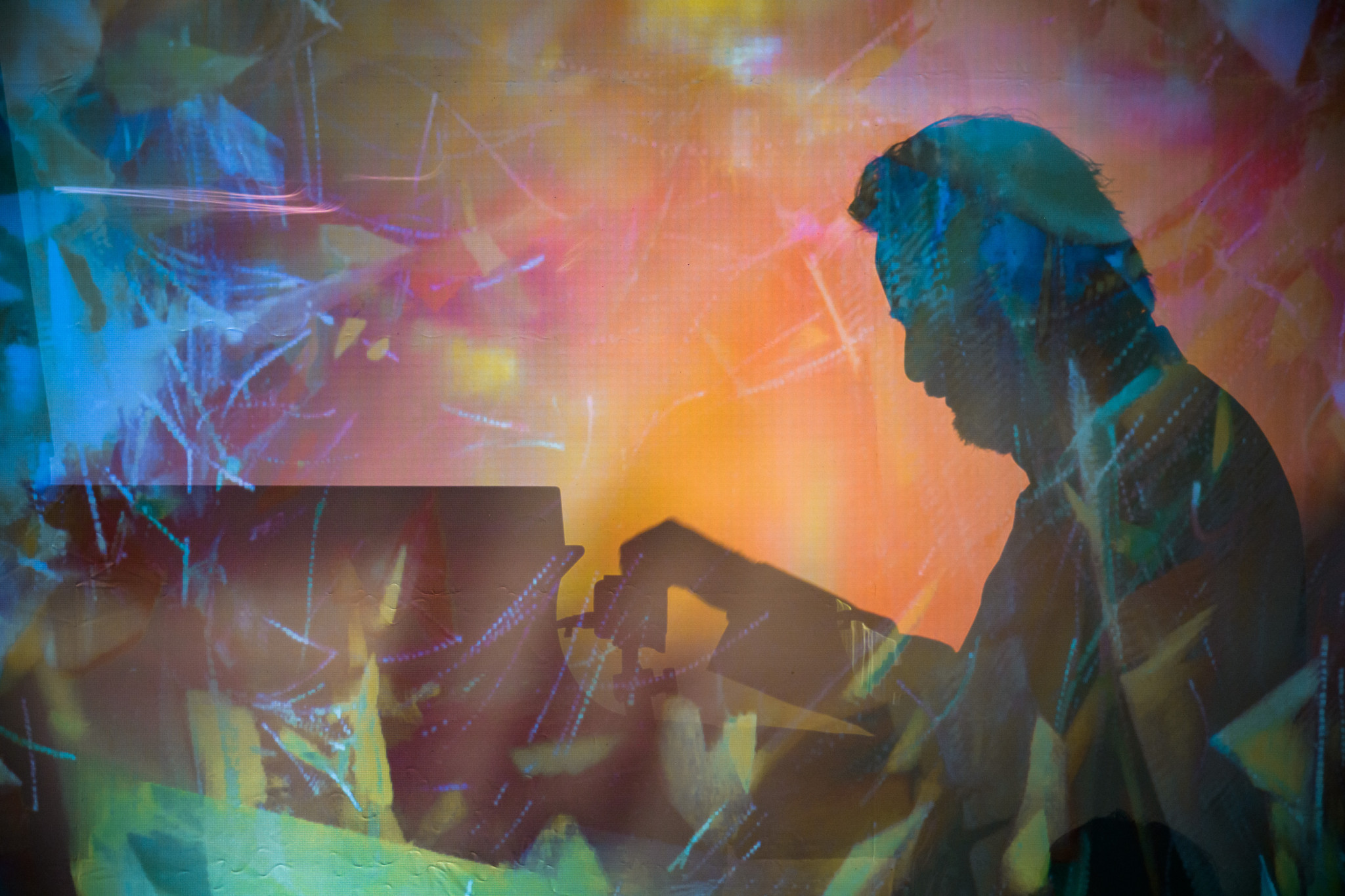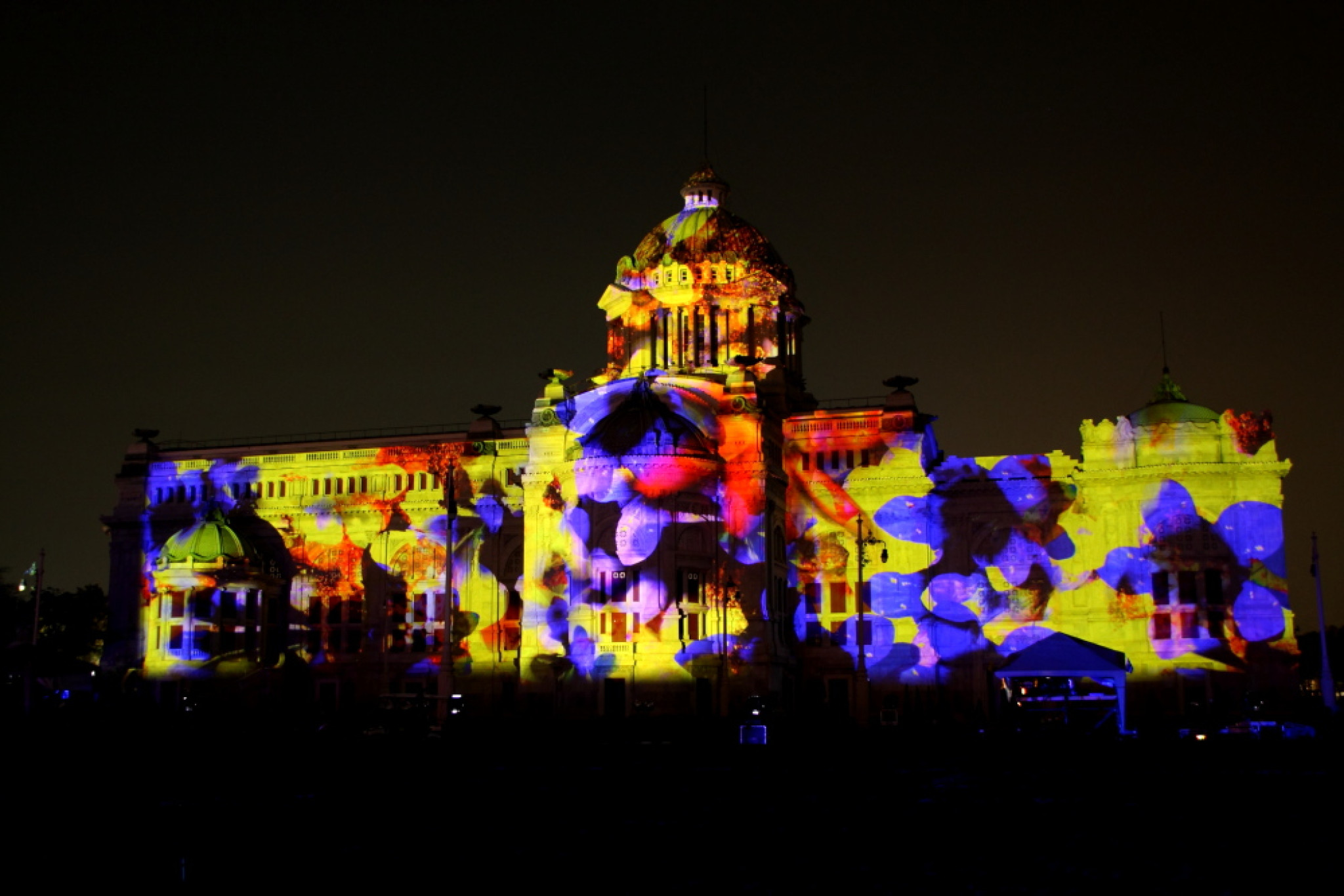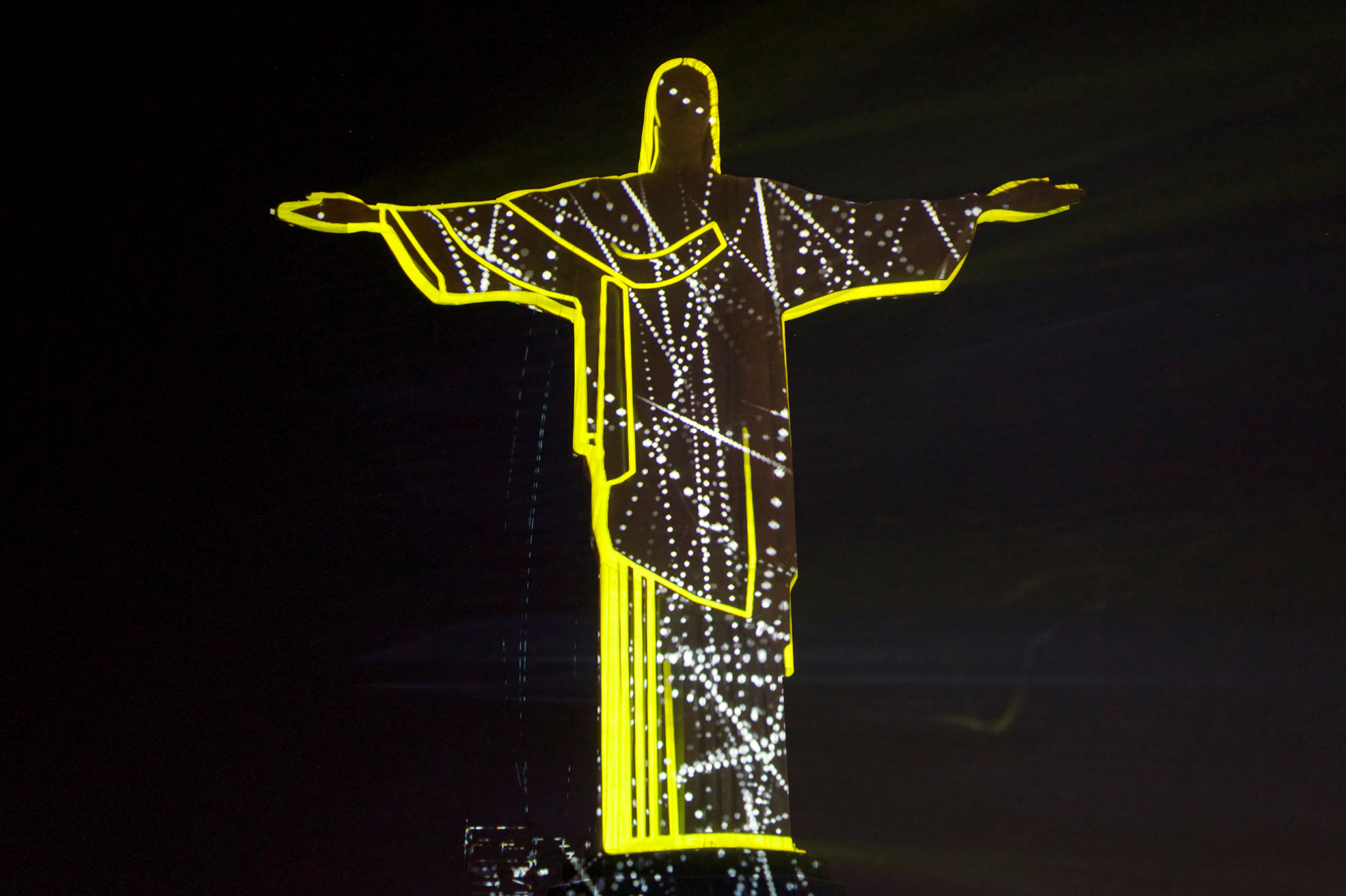Visual artist Philipp Geist works internationally with the media of video/light installation, photography and painting. Especially known for his cutting-edge video mapping installations, Geist uses civic architecture as canvases, transforming buildings into moving, painterly light sculptures that challenge the onlookers' perception of two- and -three dimensionality. His work has taken him all over the world and won him many awards, and include a video installation on the statue of Christ the Redeemer in Rio de Janeiro, a 4D mapping installation on the facade of the royal throne in Bangkok, and light installations in Frankfurt, Pune, Tehran, and Dakar on the occasion of the Art Biennale. Having been living and working in Berlin since 1999, his work can be regularly experienced at the Yellow Lounge concerts in Berlin.
 Yellow Lounge - © Stefan Hoederath
Yellow Lounge - © Stefan Hoederath
You grew up in Weilheim OBB—what made you come to live in Berlin in 1999?
At that time, Berlin was in transition. The city had a raw, unfinished energy, which was incredibly inspiring for artists. There were vast, unused spaces and a sense of freedom that attracted many creative people. It wasn’t yet the global hub for tourists or creative industries that it is now, but it was buzzing with artists from all over the world who were drawn to its openness and affordability. For me, it was the perfect environment to experiment and grow as an artist. In the early years, Berlin was a big playground for creativity and art.
How did you get into the visual arts initially? Did you study it, or just jump in, so to speak?
I am self-taught. At 13, I started intensively photographing, followed by painting large-format images. My first exhibition, at age 20, featured large-format paintings displayed in a forest. Around the same time, I began audiovisual projects with the Weilheim music scene, collaborating with musicians like Martin Gretschmann (Console/Acid Pauli) in 1996/1997. I also created audiovisual works and music videos for Tied & Tickled Trio, Console, Philip Boa, and Phonem. I didn’t follow a conventional path; my curiosity and drive to express myself visually led me to explore painting, photography, and eventually video and projection in the late ’90s. Over time, this self-guided exploration became my education.
You have worked with everything from projection mapping and light installations to photography, fine art, and painting. Was there a process to combine these things gradually, or have you always mixed everything together?
It was a gradual process. Each medium offered something unique and added to my visual vocabulary. My early work focused on painting and photography, but I became fascinated by the idea of transforming spaces with light and video in the late ’90s. I also see myself as a painter who works with different media. Today, my practice is about finding new ways to integrate and expand these elements across all of my media, including large-scale outdoor installations, audiovisual projects, immersive media installations, paintings, and fine art prints.
Can you describe to us what a ‘video mapping installation’ is, and when you started working with these?
A video mapping installation involves projecting video or light onto surfaces—be it buildings, objects, or rooms—in a way that enhances or transforms their shape and texture. I’ve always been fascinated by making the space between the projector and the projection surface visible. Through multidimensional projections on transparent gauze banners, theater fog, or water, the projection becomes visible in space and can be experienced in three dimensions. It’s about creating immersive experiences that reimagine space. I started working with projection in the late ’90s and with video mapping around 2004/2005. My first video mapping project was in Zurich, projected onto a building for several weeks in 2005. Other notable projects include work at the Berlin Kulturforum, the Museum Palazzo delle Esposizioni in Rome, and a grand installation for King Bhumibol’s throne hall in Bangkok, which drew over 2.5 million visitors.
 Bangkok / Thailand 2009 Ananta Smakhom Throne Hall - © Philipp Geist / VG Bildkunst Bonn 2025 / Videogeist.de
Bangkok / Thailand 2009 Ananta Smakhom Throne Hall - © Philipp Geist / VG Bildkunst Bonn 2025 / Videogeist.de
Presumably technology has changed a lot since you started this kind of work. Can you say a few words about that journey and how things are now?
The evolution of technology has been astonishing. When I started, I worked with bulky projectors, lower resolutions, and limited software. Today, the tools are far more powerful and accessible, from high-lumen projectors to advanced software that allows for real-time visuals. However, these advancements bring new challenges, such as managing ever-larger data files, staying updated on software, and meeting higher audience expectations. Despite these challenges, the possibilities today are nearly limitless.
Your work has been shown in many places, and you’ve won many awards. What have been your favorite projects or most cherished experiences or prizes?
Each project holds a unique place in my memory. Some of my most cherished experiences include the video mapping project on the Cristo the Redeemer statue and Santa Marta favela in Rio de Janeiro. Other unforgettable moments include installations in Pune, India, and Jerusalem in 2018. These projects were both technically and emotionally impactful. My greatest reward is the opportunity to connect with audiences worldwide through my work.
 2014 Rio de Janeiro, Cristo Redentor - © Philipp Geist / VG Bildkunst Bonn 2025 / Videogeist.de
2014 Rio de Janeiro, Cristo Redentor - © Philipp Geist / VG Bildkunst Bonn 2025 / Videogeist.de
You have been working with Deutsche Grammophon’s Yellow Lounge since 2004. How has that evolved conceptually and visually since you’ve been involved?
The Yellow Lounge has been a fascinating project. I love working with music, and collaborating with classical musicians is incredibly inspiring. The idea of bringing classical music into non-traditional spaces was revolutionary. Over time, my artistic approach has evolved, as has the visual concept for the Yellow Lounge. The initial idea for the project was to use video to increase the visibility of the musicians in the small, labyrinthine clubs. I then developed this further and integrated and interwove the musicians' live feeds into my immersive and site-specific installations. These spatial projections have certainly fundamentally expanded the Yellow Lounge. The multidimensional and walk-in situation has always been very important to me in my work.
 Yellow Lounge - © Stefan Hoederath
Yellow Lounge - © Stefan Hoederath
What have been your personal favourite shows or artists to work with?
Collaborating with musicians and performers is always inspiring. I’ve had so many magical nights with the Yellow Lounge, featuring fantastic musicians like Daniel Hope, Anne-Sophie Mutter, Alice Sara Ott, Max Richter, Mari Samuelson, and Daniil Trifonov. Beyond the Yellow Lounge, I’ve collaborated with orchestras like the Baltic Sea Philharmonics and the Nordic Pulse Ensemble, as well as conductors like Eímear Noone and Kristjan Järvi. These collaborations have offered unique opportunities to experiment with blending visuals and music in dynamic ways.
What would be your ultimate show if you had no budget, artist, technological, or venue restrictions?
That’s an exciting question! I’d love to create a large-scale immersive installation that spans an entire city—turning its buildings, streets, and public spaces into a cohesive, interactive light and soundscape. It would be about creating a collective experience that transforms everyday life into something extraordinary. In my light art festival projects, such as Lichtkunst Weilheim and Katerbow Leuchtet, I’ve already transformed entire places alone or with colleagues, but scaling that concept to a full city would be a dream.
More info: www.videogeist.de
Words by Paul Sullivan

